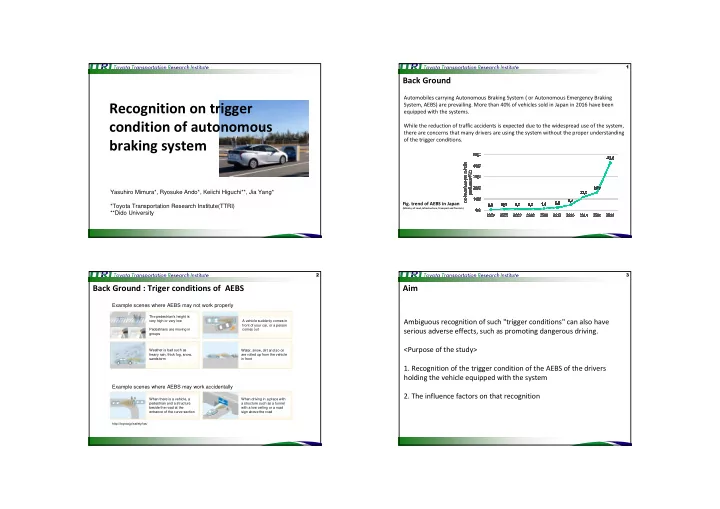

1 Back Ground Automobiles carrying Autonomous Braking System ( or Autonomous Emergency Braking Recognition on trigger System, AEBS) are prevailing. More than 40% of vehicles sold in Japan in 2016 have been equipped with the systems. condition of autonomous While the reduction of traffic accidents is expected due to the widespread use of the system, there are concerns that many drivers are using the system without the proper understanding of the trigger conditions. braking system Yasuhiro Mimura*, Ryosuke Ando*, Keiichi Higuchi**, Jia Yang* Fig. trend of AEBS in Japan *Toyota Transportation Research Institute(TTRI) (Ministry of Land, Infrastructure, Transport and Tourism) **Dido University 2 3 Back Ground : Triger conditions of AEBS Aim Example scenes where AEBS may not work properly The pedestrian's height is Ambiguous recognition of such "trigger conditions" can also have very high or very low A vehicle suddenly comes in front of your car, or a person Pedestrians are moving in comes out serious adverse effects, such as promoting dangerous driving. groups <Purpose of the study> Weather is bad such as Water, snow, dirt and so on heavy rain, thick fog, snow, are rolled up from the vehicle sandstorm in front 1. Recognition of the trigger condition of the AEBS of the drivers holding the vehicle equipped with the system Example scenes where AEBS may work accidentally 2. The influence factors on that recognition When there is a vehicle, a When driving in a place with pedestrian and a structure a structure such as a tunnel beside the road at the with a low ceiling or a road entrance of the curve section sign above the road http://toyota.jp/safety/tss/
4 5 Method Method How to analyze recognition of the trigger conditions How to identify influence factors regarding recognition of AEBS trigger conditions -The trigger conditions of AEBS were referenced from the automaker's website -Asking “personal attitude” and “contact opportunities of information on AEBS” to drivers -Asking understanding of each trigger condition through a questionnaire survey who own his/her vehicle equipped with AEBS -As preprocessing of analysis of factors influencing AEBS recognition, Principal Component -Developing a multiple regression model with the Recognition of the trigger condition of the Analysis (PCA) is carried out to integrate each recognition of trigger conditions AEBS Factors1: Personal attitude Example scenes where AEBS may not work properly -Age The pedestrian's height is very small or very large A vehicle suddenly comes in front of your car, or a person -Gender Pedestrians are moving in comes out groups -Ability of daily living -Size of vehicle (light, small, regular) Recognition Weather is bad such as Water, snow, dirt and so on heavy rain, thick fog, snow, are rolled up from the vehicle Recognition -Driving frequency (per week) sandstorm in front of the trigger of the trigger -Driving style conditions conditions Factors2: Contact opportunities Example scenes where AEBS may work accidentally of information on AEBS When there is a vehicle, a When driving in a place with pedestrian, a structure a structure such as a tunnel beside the road at the with a low ceiling or a road - Experience of the AEBS before/after entrance of the curve sign above the road purchasing http://toyota.jp/safety/tss/ -Reference level of information about AEBS provided by various mediums(TV, magazine, etc.) 6 7 Method Method How to evaluate Ability of daily living How to evaluate driving style -Using the Japan Science and Technology Agency Index of Competence (JST-IC) 1)2) to get the -Using Driving Style Questionnaire (DSQ) developed by Research Institute of Human Engineering for Quality Life 1) to get the data of driving style data of Ability of daily living -DSQ has 8 scales composed of 18 questions *Respondents answer with yes(=1 point) or no(=0 point) *The score is calculated by the sum of the answers with each category. Can you use a mobile phone? *Respondents answer each question with 4 levels Can you use ATM? Use of new equipment (from “quite applicable” to “not at all”) Can you operate video or DVD player? *The score of each scales are calculated by the sum Can you mail a mobile phone or a personal computer? of the each answer Are you interested in foreign news and events? Can you judge the authenticity of health information? Information gathering Do you sometimes appreciate art objects, movies, music? Do you watch educational programs? Are you taking measures to avoid suffering from fraud, snatching, burglar, etc.? Do you have a bit of ingenuity in your life? Life management Can I take care of a sick person? Are you looking after your family or acquaintances? Are you participating in regional festivals and events? Are you participating/active in the neighborhood association? Social participation Can you take care of the local residents' association or undertake a board member of that? Are you doing any volunteer activities? 1) Motonori Ishibashi, Masayuki Okuwa, Shun'ichi Doi, Motoyuki Akamatsu: Indices for characterizing driving style and their relevance to car following behavior, SICE Annual Conference 2007, DOI: 10.1109/SICE.2007.4421155 2) 1)Iwasa H, Masui Y, Inagaki H, Yoshida Y, Shimada H, Otsuka R, Kikuchi K, Nonaka K, Yoshida H, Yoshida H, Suzuki T: Assessing competence at a higher level among older adults: Development of the 2) http://www.cit.nihon-u.ac.jp/kouendata/No.38/1_kikai/1-029.pdf (in Japanese) Japan Science and Technology Agency Index of Competence (JST-IC), Aging Clinical and Experimental Research. 2)Iwasa H, Masui Y, Inagaki H, Yoshida Y, Shimada H, Otsuka R, Kikuchi K, Nonaka K, Yoshida H, Yoshida H, Suzuki T: Development of the Japan Science and Technology Agency Index of Competence (JST-IC) to assess functional capacity in older adults: Conceptual definitions and preliminary items. Gerontology and Geriatric Medicine 2015; 1: 2333721415609490, doi:10.1177/2333721415609490.
Recommend
More recommend